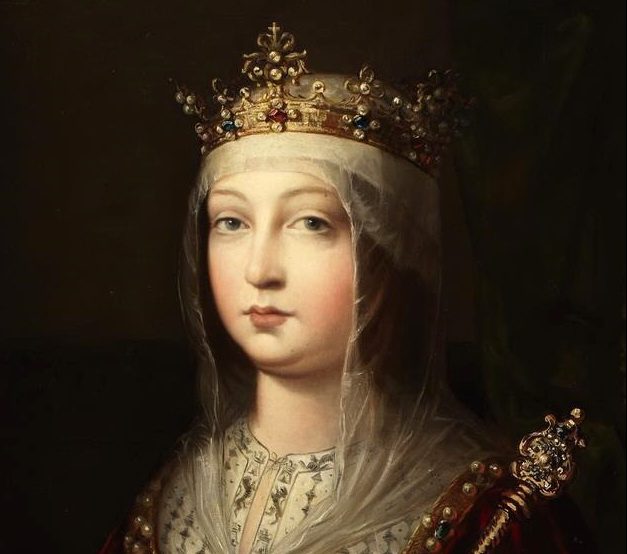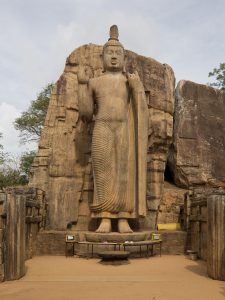In April of 1451, at a secluded palace in Northern Spain, a young baby by the name of Princess Isabella of Castile was born. From the moment she was born the world was aligned against her. In truth, there were very few people who cared at all for the infant princess. Her older half-brother Enrique was poised to become the next king of Castile, and his children, when they came, were next in line to the throne. Isabella was nothing but a mere princess with no realistic prospect of becoming queen. However, despite the hardships she would face, this young infant princess would rise to become the maker of the most powerful kingdom and empire in the world.1
As Isabella grew, her family’s political position began to deteriorate. Her father, King Juan II, was heavily influenced by the callous and greedy general, Alvaro de Luna. King Juan, entirely uninterested in the affairs of state, allowed De Luna to have a free hand in the kingdom. Thus, by the time of King Juan’s death in 1454, Castile was plagued with corruption and dissent. His eldest son, Enrique IV was an even worse king. He was a great lover of debauchery, and many times he neglected his duties as king. By the end of his reign, the kingdom would be in complete disarray.2 Meanwhile, Isabella spent most of her time in seclusion with her now widowed mother. During this time, she developed a strong faith in God, and the rituals of the Catholic faith became the bedrock of her young life, as well as her primary source of strength and motivation. But for now, there was nothing she could do about the chaos consuming the kingdom.3 As Isabella’s childhood passed into her teenage years, the question on everyone’s mind was, who should the young princess marry. The hope for Isabella was that she would marry a man who could help bring unity to a fractured peninsula, and, in time, she would do just that.
For centuries, the Iberian peninsula had prospered as part of the Roman Empire. However, after the fall of the Western Roman Empire in the fifth century, a power vacuum developed in Iberia. It was quickly filled by the fierce warrior-like Visigoths, who established their own kingdom throughout the peninsula as well as in southern France. For many centuries, the Visigoths prospered in Spain. They crafted intricate jewelry and introduced their own unique architectural style to the region. However, the most influential cultural impact they had was their adoption of Christianity. The importance of this decision cannot be understated. The new religion imbued its Iberian adherents with a fiery sense of purpose, an attribute that would lead them to greatness in later centuries, as Christianity would go on to play an important role in the formation of the future Kingdom of Spain and its empire. But the peace and prosperity that blessed the Visigoth Kingdom would not last forever. A new and ominous threat had gathered force on its southern horizon, and it had one goal: conquest.4The ominous new threat that came surging out of northern Africa in the eighth century was a brand new religion. The Prophet Muhammad preached that his new religion, Islam, was the greatest of the monotheistic faiths. In the year 711, warriors of the new religion surged into the Iberian Peninsula. The kingdom of the Visigoths, weakened by internal division, was in no condition to face their fierce foes. One by one the cities of Iberia fell under the sway of the Muslim forces. The Christian kings of Iberia were pushed back to the Pyrenees. In a short time, the Muslims dominated the peninsula.5 However, the Muslims were not just conquers. They brought with them a vibrant and lively culture. As well as bringing their new faith, they introduced leather making, and Muslim architecture. In fact, at the Muslim capital of Cordoba, under the direction of Caliph Abd-ar- Rahman I, the great mosque of Cordoba was built, and it became the third most important mosque in the world after those in Mecca and Jerusalem.6 Also, in Muslim Iberia trade, philosophy, and theology prospered to an extraordinary extent. For the Christian kings, however, none of this was important. To them, the Muslim faith was a menace that had to be pushed back, and the Christians were going to try and do just that.
In the wake of the Muslim invasion, the Christian kings of Iberia were almost swept off the peninsula. However, they intended to win back every inch of the land that they had lost. Thus began a long period in Iberian history known as the Reconquista, which would last for over 700 hundred years. Little by little, the Christian kingdoms of the north took back the land they had lost. They took back Toledo in 1085, and then Seville in 1248. Ever so slowly, the Christian kingdoms pushed back their foes. By the time of Isabella’s birth, there were only five kingdoms left in Iberia: Castile, Aragon, Navarre, Portugal, and the final Muslim outpost of Granada. However, before they could conquer Granada, the Christian kingdoms needed to achieve unity among themselves. And that is where Isabella would play a vital role.7

Now that everything had settled down in Castile, Isabella was free to continue her pursuit of a suitable husband. Her attention turned to Castile’s neighbor, Aragon. Since Isabella was now the heir to the throne of Castile, she decided that pursuing a marriage with Ferdinand, heir to the throne of Aragon, was the most desirable option. Ferdinand was a young, handsome, intelligent, and charming man. Together, the two young expectant monarchs represented the bright future of their kingdoms. Finally, after much delay, Ferdinand arrived at the Castillian city of Valladolid, where his soon to be wife was waiting for him.9 On October 19, 1469, the couple finally wed.10 The union of the two future monarchs would shape the destiny not just of their kingdoms, but also of the world. Now all Ferdinand and Isabella had to do was wait. When Isabella’s brother died, she would inherit the kingdom of Castile, and when Ferdinand’s father died, he would inherit the kingdom of Aragon. Thus, the two kingdoms would be effectively transformed into one.

Finally, in 1474, the couple’s time arrived. Over the past five years, Isabella’s power and support in the kingdom had grown, and King Enrique’s health had also become more fragile. Finally on December 11, 1474 King Enrique died. Isabella moved quickly to consolidate her power. She quickly sent out a letter to the kingdom announcing the death of her brother and asserting her right to rule. In the city of Segovia, where Isabella was staying, she celebrated mass, and then she changed into a splendid outfit laced with gold and precious gems. Before a crowd of cheering people, she became queen. The city celebrated with a procession of Isabella’s allies who were eager to declare their allegiance to the new sovereign. It was truly a momentous occasion. But all was not well. Despite the convincing illusion of power, there were many of Isabella’s enemies who sought her throne.11 King Alfonso V of Portugal, with Enrique’s young daughter Juana by his side, declared himself King of Castile and invaded the country.12 Isabella sent Ferdinand to intercept the Portuguese army commanded by King Alfonso. At the battle of Toro, Ferdinand decisively defeated the Portuguese army. Finally, in 1479, after signing the treaty of Alcacoavs, Isabella and Ferdinand’s rule was cemented, and they were the only rulers of Castile. Also, Ferdinand’s father died in 1479, and Ferdinand ascended to the throne of Aragon.13 At last, Isabella and Ferdinand ruled a united and powerful kingdom—the Kingdom of Spain. Finally, Isabella could turn her attention to conquering the kingdom that, for so long, had eluded her ancestors. It was time to vanquish Granada and expel the Muslims from Spain.
In 1481, the final stage of the Reconquista commenced. The Muslims, believing that Spain was weak from its wars with Portugal, attacked the town of Zahara. The attack was a complete success and the Muslims believed that the Spanish government would not respond. However, they were wrong. The Spain of Isabella and Ferdinand was much more powerful than its predecessor, Castile, had been in the past. Flushed with the wealth and power of her new state, Isabella intended not only to strike back, but to finish the Reconquista once and for all. The Spanish army swept into Granada, and captured the town of Alhama. This center of commerce was not even twelve miles from the capital city of Granada. Victory was within Isabella’s grasp. At the same time, civil war broke out in Granada. Here, Isabella now saw an opportunity. She offered the ruler of Granada, Boabil, a two-year truce, which he gratefully accepted. In the interim, Isabella planned to continue strengthening her forces for the final assault, while the civil war in Granada waged on, weakening the state’s ability to resist the Catholic conquerors. The plan worked well, and by the time the campaign resumed, Granada had torn itself apart. The Catholic forces moved swiftly from one fortress to the next, taking each after a hard fought battle. Finally, on January 2, 1492, the city of Granada surrendered. Isabella was victorious. All of Iberia was now in the hands of the Christians once more. After 700 years, Isabella had achieved the goal that had eluded her predecessors for so long. The final outpost of the Muslim faith in Iberia was gone forever.14 With that goal accomplished, Isabella could now pour her country’s resources into new and exciting adventures elsewhere. Indeed, the world had grown wider since the last time Iberia had been united, and there were many things to learn and to explore.
In the fourteenth and fifteenth centuries, Western Europe underwent colossal changes. The nations of Europe awoke from the slumber of the dark ages to an entirely different world. A world, rich with resources and luxury goods, lay just beyond their grasp in the East Indies. The first European nation to branch out was Portugal, which, due to its excellent location on the western shore of the Atlantic Ocean, took the first steps into a larger world. In the mid-fifteenth century, Portugal began raiding Muslim settlements on the coast of North Africa. The raiders who returned brought home gold artifacts and other fine goods. From then on Portugal would go on to establish colonies up and down the western coast of Africa, and much wealth flowed out of these colonies back to Portugal. The Portuguese took another large step when, in 1488, Bartolomeu Dias sailed around the southernmost tip of Africa. This monumental voyage opened India and the far east to European trade, and Portugal was the first nation to establish European colonies in India, the Persian Gulf, Macao, and Sri Lanka. Portugal’s overseas expansion brought much wealth to the small country. In a matter of mere decades Portugal transformed itself into one of the most powerful countries on Earth. If Spain, or any other country in Europe for that matter, wanted to keep up, they too would need colonies and trade routes that rivaled those of Portugal. But in order to surpass Portugal, the nations of Europe would need to find a new and faster route to the East Indies. That is where one man, a well known sailor from Genoa, would play a vital role in changing the history of the world forever, and give Spain a decisive edge over its neighbor.15 The year 1492 began with tremendous success for Isabella. The kingdom of Granada fell early in the year, and as a result, Spain became a major voice on the European continent. Isabella’s own prestige was impressive. She had transformed herself into one of the most formidable monarchs in Europe, and she was certainly the most powerful woman in the world. It seemed as if she had reached her zenith, but this was not true. For many years, a brilliant Italian navigator, Christopher Columbus, had been lobbying Isabella for money and supplies to conduct a voyage to the East Indies. Columbus believed that he could bypass Portuguese strongholds in the far east by sailing west across the Atlantic Ocean. Yes, the feat was dangerous and highly romantic, but if it succeeded, Spain would have a new and quicker passage to the Far East. In the past, Isabella had been reluctant to commission voyages, but now that the war with Granada was over, she finally decided to give Columbus her approval. So, a half hour before sunrise on August 3, 1492, Columbus embarked from the port of Palos. In his charge he had three ships, the Nina, Pinta, and Santa Maria, as well as ninety men. The small squadron sailed on into the open and uncharted ocean for five weeks. The sailors grew restless, and the officers questioned Columbus’ capacity for leadership. They thought that he had led them into an endless sea, and they lost hope that they would ever see land again. However, they were wrong. Early in the morning on October 12, 1492, a sailor on board the Pinta shouted, “Land.” When the men peered out from their ship, they saw laid out before them a tropical paradise situated on a small island, most likely one of the Bahamas. Columbus spent over two months exploring the Bahamas and finding new islands. He met local Native Americans, with whom he traded and lived. In December, he claimed the island of Haiti for Ferdinand and Isabella and named it San Salvador. Thus it was that one of the first possessions of the Spanish Empire was claimed. However, Columbus could not stay forever, and in January of 1493, he departed for Spain. When Columbus returned, Isabella happily received him in the city of Barcelona. She was overjoyed by the results of his voyage, and she eagerly agreed to finance more journeys. She also lavished him with new titles in recognition of his achievements on behalf of Spain. The year 1492 was a monumental year, but the voyages of Christopher Columbus were the crowning achievement of the age. It was the beginning of a new era in world history, and Isabella was responsible for it. If it had not been for her willingness to send men into the unknown, the world might be a radically different place. Thus, when 1492 drew to a close and the new year dawned, Isabella reached the height of her power, as Spain was now poised to found a new empire across the seas that would bring it immeasurable riches.16
The reign of Queen Isabella of Spain was one of the most consequential in world history. Her incredible sense of duty, her commitment to faith, and her love for her country drove her to do great things. She is the founder of not only the Kingdom of Spain, but also, the Spanish Overseas Empire. Spain would go on to acquire territory in both Central and South America, Italy, and the Netherlands. Her actions shaped the history of two continents, and her legacy still endures today. Wherever, in these distant lands, the Spanish language is spoken, wherever the Catholic faith is practiced, we have Isabella to thank.
- Kirstin Downey, Isabella: The Warrior Queen (New York: Doubleday , 2014), 3. ↵
- John Fraser Ramsey, Spain: The Rise of the First World Power (Alabama: University of Alabama Press, 1973), 104-105. ↵
- Kirstin Downey, Isabella: The Warrior Queen (New York: Doubleday, 2014), 40-41. ↵
- Kirsten Downey, Isabella: The Warrior Queen (New York: Doubleday, 2014), 11-12. ↵
- Kirstin Downey, Isabella: The Warrior Queen (New York: Doubleday, 2014), 12-15. ↵
- John Fraser Ramsey, Spain: The Rise of the First World Power (Alabama: University of Alabama Press, 1973), 36. ↵
- John Fraser Ramsey, Spain: The Rise of the First World Power (Albama: University of Alabama Press, 1973), 50, 78. ↵
- Kirstin Downey, Isabella: The Warrior Queen (New York: Doubleday, 2014), 53-63, 67-68. ↵
- William Hickling Prescott, History of the Reign of Ferdinand and Isabella (New York: The Heritage Press, 1967), 46, 49. ↵
- Salem Press Encyclopedia, 2013, s.v. “Marriage of Ferdinand and Isabella,” by Paul Stewart. ↵
- Kirstin Downey, Isabella: The Warrior Queen (New York: Doubleday, 2014), 129-132. ↵
- William Hickling Prescott, History of the Reign of Ferdinand and Isabella (New York: The Heritage Press, 1967), 58. ↵
- Salem Press Encyclopedia, 2013, s.v. “Marriage of Ferdinand and Isabella,” by Paul Stewart. ↵
- John Fraser Ramsey, Spain: The Rise of the First World Power (Alabama: University of Alabama Press, 1973), 215-223. ↵
- The Gale Encyclopedia of U.S History: Government and Politics, 2008, s.v. “The Pre-Colonial Era: 1450-1620.” ↵
- Kirstin Downey, Isabella: The Warrior Queen (New York: Doubleday, 2014), 235-253. ↵




141 comments
Hali Garcia
Great article! I love learning about the monarchs. Queen Isabella of Spain is one of my favorites. I find it so interesting what all she did to gain and grow her kingdom. I like how you did not focus mainly on Columbus because sometime that is all she is known for. Queen Isabella is truly a fascinating person because of her dominance and the strength of her kingdom.
Diamond Davidson
The structure of this article is amazing and I just love the way the article flowed really well. I like how it started with her childhood and it started to go into when she was over and started to gain power. It had a beginning middle and end that flowed throughout the article. It is very explanatory about a woman’s power. I admire how she took over the throne after her brother Enrique left.
Diego Terrazas
Queen Isabella was a notable monarch in history due to her range of accomplishments. She is somebody who proved everybody wrong a became a worthy Queen, one in which kings may not even compare. I did not know it was because of her that Spanish is spoken in distant land as well as the Catholic religion. I like the way she asserted dominance.
Sarah Uhlig
I really enjoyed reading about Queen Isabella and how she ruled land differently as some would call it. I liked learning about her life and understanding more about the political side of things during this time. I think the author developed a very good, descriptive article that stands out from others in how the title was interesting and how the first paragraph stood out from the others. Well done writing this excellent article.
Mariah Cavanaugh
I enjoy reading articles that focus on women in power, especially the powerful Isabella. As you pointed out in your article, Isabella and Ferdinand’s reign had a huge impact on Portugal. Which was so much more than financing Christopher Columbus’ expedition. You did a wonderful job recounting all that Isabella and Ferdinand accomplished beyond Columbus and all that Isabella had to do to retain her place of power.
Engelbert Madrid
Queen Elizabeth of Spain was surely one of the important figures of Spanish expansion during her reign. She was quite intelligent and knew exactly what her main goals were. She knew that by marrying Prince Ferdinand was going to be a strategic way of uniting their powers and expanding it through the Iberian peninsula. I enjoyed reading this article and learning more about Queen Isabella and King Ferdinand.
Nathalie Figueroa Soto
I really enjoyed reading this article. I had learned about Ferdinand and Isabella before in high school history classes, but never in as much detail as was given to me in this article. The story of how Spain came to be a superpower in the world was an interesting one to read. Isabella had a difficult childhood, but she still rose up and united her country. Like the end of the article states, wherever the Spanish language is spoken or the Catholic religion is practiced, we have Isabella to thank. This was a very informative article, well done.
Maya Mani
Mad respect for this woman! She truly is a powerhouse, I love articles that highlight the successful influence women can have if their given the position! It was also a really well written article, I think she definitely paved the way for a new way of ruling in the years to come. It’s so wonderful to read about how much she accomplished and transcending the preconceived notions of a women’s influence on society.
Rosario Moreno
I have always heard of Ferdinand and Isabella, but never in too much detail so I glad you did this article.it was sad to hear that Isabella’s Kingdom was consumed of corporation and lies. It was crazy to read that so many wanted her throne and they hated Isabella.I was happy to read that she made a great Queen and that during her time her kingdom did thrive. Great article, super informative!
Christopher Metta Bexar
Nicely researched. We need an article to explain some of what created European politics in the 16th century. By the time Ferdinand and Isabella finished they had ties to half the important families in16th century Europe ( including having a member of the family as Holy Roman Emperor).
This is a good introduction to a class like HS 1352.